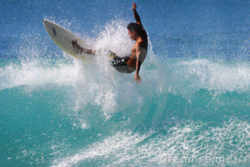
Hawaii Symbols
Hawaii State Individual Sport
Surfing

Adopted in 1998.
Hawaii designated surfing as the official state individual sport in 1998 (outrigger canoe paddling was adopted as the official Hawaii team sport in 1986).
The riding of waves has likely existed since humans began swimming in the ocean. In this sense, bodysurfing is the oldest type of wave-catching. Standing up on what is now called a surfboard is a relatively recent innovation developed by the Polynesians. The influences for modern surfing can be directly traced to the surfers of pre-contact Hawaii. It was recently found that the ancient people from Peru used to ride the waves of Trujillo in their Caballitos de Totora
Hawaii State Individual Sport: Surfing

The art of surfing, called he'enalu
in the Hawaiian language, was first described in 1769 by Joseph Banks on the HMS Endeavour during the third voyage of Captain James Cook. Surfing was
a central part of ancient Polynesian culture and predates European contact. The chief (Ali'i) was the most skilled wave rider in the community with
the best board made from the best tree. The ruling class had the best beaches and the best boards, and the commoners were not allowed on the same beaches,
but they could gain prestige by their ability to ride the surf on their ratchet boards.
The sport was also recorded in print by other European residents and visitors who wrote about and photographed Samoans surfing on planks and single
canoe hulls; Samoans referred to surf riding as fa'ase'e or se'egalu. Edward Treager also confirmed Samoan terminology for surfing and surfboards in
Samoa. Oral tradition confirms that surfing was also practiced in Tonga, where the late king Taufa'ahau Tupou IV was the foremost Tongan surfer of
his time.
When the missionaries from Scotland and Germany arrived in 1821, they forbade or discouraged many Polynesian traditions and cultural practices, including,
on Hawaii, leisure sports such as surfing and holua sledding. By the 20th century, surfing, along with other traditional practices, had all but disappeared.
Only a small number of Hawaiians continued to practice the sport and the art of crafting boards.
Ancient Hawaii
The Ancient Hawaiian people did not consider surfing a mere recreational activity, hobby, extreme sport, or career as it is viewed today. Rather,
the Hawaiian people integrated surfing into their culture and made surfing more of an art than anything else. They referred to this art as he'e nalu
which translates into English as "wave sliding."The art began before entering the mysterious ocean as the Hawaiians prayed to the gods for
protection and strength to undertake the powerful mystifying ocean. If the ocean was tamed, frustrated surfers would call upon the kahuna (priest),
who would aid them in a surfing prayer asking the gods to deliver great surf. Prior to entering the ocean, the priest would also aid the surfers (mainly
of the upper class) in undertaking the spiritual ceremony of constructing a surfboard.
Hawaiians would carefully select one of three types of trees. The trees included the koa (Acacia koa), 'ulu (Artocarpus altilis), and wiliwili (Erythrina
sandwicensis) trees. Once selected, the surfer would dig the tree out and place fish in the hole as an offering to the gods. Selected craftsman of
the community were then hired to shape, stain, and prepare the board for the surfer. There were three primary shapes: the 'olo, kiko'o, and the alaia.
The 'olo is thick in the middle and gradually gets thinner towards the edges. The kiko'o ranges in length from 12-18 feet (3.7-5.5 m) and requires
great skill to maneuver. The alaia board is around 9 feet (2.7 m) long and requires great skill to ride and master. Aside from the preparatory stages
prior to entering the water, the most skilled surfers were often of the upper class and pastors including chiefs and warriors that surfed amongst the
best waves on the island. These upper class Hawaiians gained respect through their enduring ability to master the waves and this art the Hawaiians
referred to as surfing. Some ancient sites still popular today include Kahalu'u Bay and Holualoa Bay.
Hawaii Law
The law designating the surfing as the official Hawaii state individual sport. is found in the Hawai`i Revised Statutes, Volume 1, Chapter 5, Section 5-13.5
Volume 1.
CHAPTER 5. EMBLEMS AND SYMBOLS.
SECTION 5-13.5
[§5-13.5] State individual sport. Surfing is adopted, established, and designated as the official individual sport of the State. [L 1998, c 174, §2]







